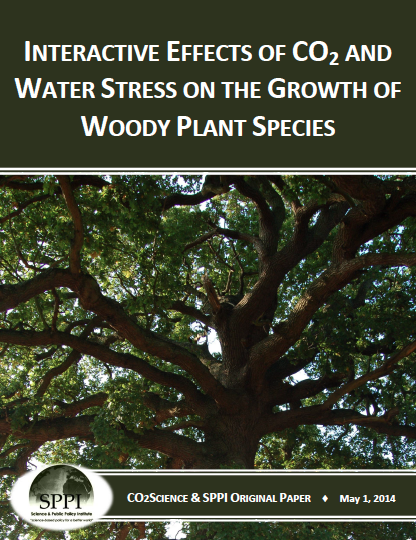News / Nature
Interactive Effects f CO2 and Water Stress n the Growth of Woody Plant Species

It is widely acknowledged that as the CO2 content of the air continues to rise, nearly all of earth's plants will exhibit increases in photosynthesis and biomass production; but climate alarmists periodically proclaim that future water stress will negate these benefits of atmospheric CO2 enrichment. In reviewing much of the pertinent scientific literature of the ten-year period 1983-1994, however, Idso and Idso (1994) determined that water stress will generally not negate the CO2-induced stimulation of plant growth. In fact, they found that the CO2-induced percentage increase in plant productivity was nearly always greater under water-stressed conditions than it was when plants were well-watered. This review thus discusses some of the subsequent relevant literature in this important research domain, in order to determine if these conclusions are still valid, particularly in the case of earth's woody species.
For starters, it is well known that during times of water stress, atmospheric CO2 enrichment often stimulates the development of larger-than-usual and more robust root systems in woody plants, which thus enable them to probe greater volumes of soil for scarce and much-needed moisture. Tomlinson and Anderson (1998)1, for example, found that greater root development in water-stressed red oak seedlings grown at 700 ppm CO2 helped them effectively deal with the reduced availability of moisture;and these trees eventually produced just as much biomass as well-watered controls exposed to air containing 400 ppm CO2. In addition, Polley et al. (1999)2 discovered that water-stressed honey mesquite trees exposed to an atmospheric CO2 concentration of 700 ppm produced 37% more root biomass than water-stressed seedlings in air of 370 ppm.
Elevated levels of atmospheric CO2 also tend to reduce the area of open stomatal pore space on leaf surfaces, thus reducing plant stomatal conductance. This phenomenon, in turn, reduces the amount of water lost to the atmosphere via transpiration; and, therefore, it was not surprising when Tognetti et al. (1998)3 determined that the stomatal conductances of mature oak trees growing near natural CO2 springs in central Italy were significantly lower than those of similar trees growing further away from the springs during periods of severe summer drought, which phenomenon allowed the CO2-enriched trees to better conserve what little water was available to them.
Read More...
